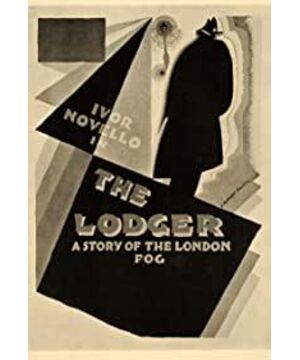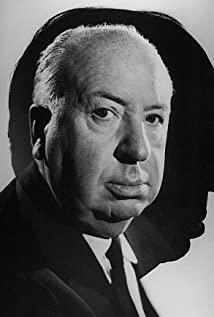Hitchcock is known as the "Master of Suspense", and 1927's The Tenant is known as the first "Hitchcock film" in the true sense of the word because of its strong Hitchcockian suspense. color.
After a seventh victim in a serial homicide, a mysterious tenant has appeared at a family hotel on the block. Is he the same killer who left the "Avengers" message? Hitchcock is to make the audience have such a doubt.
The first time we see the tenant, played by Ivor Novello, is through the eyes of the landlady. When the door opened, a tall, gloomy man appeared in the fog of London, wearing a black cloak and a scarf half covering his face. The unsuspecting landlady was taken aback, and the audience who had just seen what witnesses called "the murderer was tall and masked" must have been even more suspicious.
The director continued to cast doubts. In the hotel room, the young lodger looked flustered when he saw the picture of the blond woman on the wall. He rummaged for a place to store a suspicious-looking bag. The extraordinary admiration he gave to the blonde when he first met the landlord's beautiful blonde daughter. While delivering breakfast, he slid the knife towards the girl. When they were playing chess, his hand rested ambiguously on the poker. The crime did not happen, but the director's camera expression seems to constantly imply to the audience that the crime can happen at any time.
As the plot progresses, the landlady discovers that he often goes out in the middle of the night, and the location of the murder is so coincidentally around the corner of their house.
There are more and more doubts, the atmosphere is getting more and more tense, and the identity of the tenant's killer seems to be revealed soon. At this time, it reached the climax of the suspense: the tenant and the blonde landlord's daughter went out in the middle of the night! At this time, the audience, like the landlord and his wife, widened their eyes, wishing they could be dragged back.
However, the murder did not happen, but the lovers kissed affectionately at the intersection. Isn't he the serial killer? we think. Stronger hints soon followed. The blonde's jealous detective boyfriend burst into the room and retrieved the handbag that had been hidden by the tenant. The tenants watched nervously and eccentrically as they found a pistol, all the news briefings about the serial murders, and a picture of a slain girl. The truth seemed to be like the handcuffs, with a crisp "click" locked on the hand of this eccentric young man.
In the dark night, the young man confided the truth to his lover: his sister, a blond girl, was the first victim of this serial murder. He was entrusted by his mother to track down the real culprit. At this point, all the mysteries have been solved: why did he come to this block, why did he go out in the middle of the night when the murder happened, why is he afraid of blonde hair and obsessed with blonde hair? ...
It turns out that this is the truth: he's not the "Avengers", but the director keeps making us wonder "Is he the 'Avengers'?"
This is what Hitchcock called "The McGuffin." McGuffin is meaningless to the truth, but it is an important object or an important clue that the whole film chases. In The Tenant, the non-existent "Avenger" is McGuffin. Until the end of the film, we didn't see the true face of "The Avengers", but the detective heard a sentence: "Ah, the real murderer has been caught!" However, the suspense of this "Avengers" firmly grasped the hearts of the audience, From the first minute to the last minute, all the plot is driven by it.
If these horror factors are removed, this may be a simple love story. A strange young man comes to London to find out the truth and falls in love with his landlord's daughter. But Hitchcock made it a thriller classic. McGuffin!
As we know, Hitchcock was a technocrat. In this film, what he is trying is how to use the camera to show the rhythm in silent films. At the beginning of the film, he used such a set of shots to show the panic caused by the murder. The reporters called the news agency, and different people received and passed on the news... The typewriters in the news agency were printing, and people were scrambling to pass it around... Newspapers sent by mail, propaganda vans with large and bold fonts driving around the city... …the news and fear spread like this.
At the end of the film, the young man, in handcuffs, is surrounded by a wall of iron fences by people who mistake him for the murderer, and he is beaten, scolded and humiliated by the crowd. The accused was imprisoned helplessly, "stoned" by an ignorant and cruel crowd, but he himself was innocent. This is the image of the crucified Christ. Hitchcock also frankly admitted that this was his intention, and even the image of a man and a cross appeared in the poster of "The Tenant", expressing this metaphor. Innocent people were charged, a theme that later appeared in Hitchcock's films, such as "The Thirty-nine Steps."
The Tenant is Hitchcock's third film. Before that, he filmed "Happy Garden" and "Mountain Eagle". In "Pleasure Garden", Hitchcock has begun to show his fascination with "abnormal", but does not reflect the deep meaning in the film. The second film, Mountain Eagle, was called a "bad" and "ridiculous" film by himself. Therefore, "The Tenant" became the first important film in Hitchcock's personal history.
The film is based on the novel "The Tenant" by Ms. Belloc Lowndes. According to Hitchcock's own account, he originally wanted to keep an open ending at the end of the film, that is, it was impossible to determine whether the young man was an "Avengers", but because Novello, who starred at the time, was a popular British drama star, he was not accepted. Produced by the producer. This has also become one of his regrets. But even so, the successful creation of a suspenseful atmosphere and the exploration of visual art are still enough to make it a "pioneering work" in the true sense of the suspense master.
View more about The Lodger: A Story of the London Fog reviews








